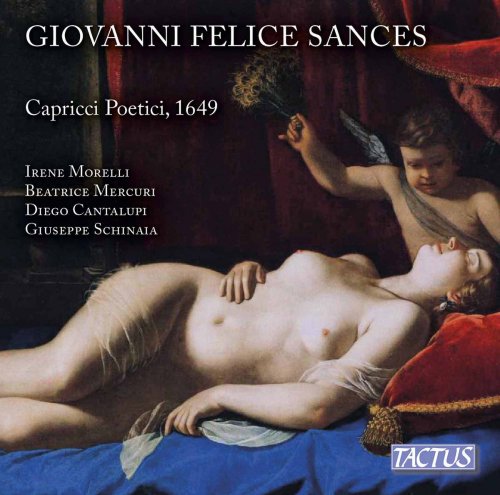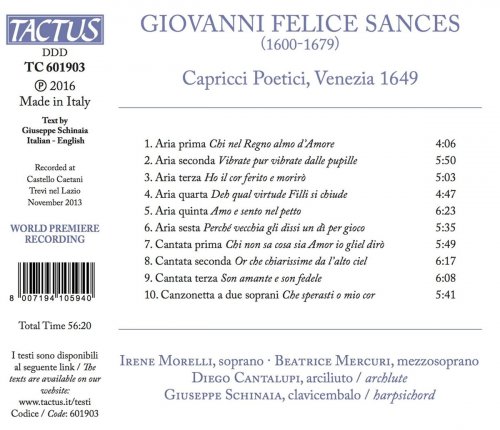Irene Morelli, Beatrice Mercuri, Diego Cantalupi & Giuseppe Schinaia - Sances: Capricci Poetici, Vol. 1 (2017)

Artist: Irene Morelli, Beatrice Mercuri, Diego Cantalupi, Giuseppe Schinaia
Title: Sances: Capricci Poetici, Vol. 1
Year Of Release: 2016/2017
Label: Tactus
Genre: Classical
Quality: flac lossless (image +.cue, log, artwork, booklet)
Total Time: 00:56:17
Total Size: 230 m
WebSite: Album Preview
TracklistTitle: Sances: Capricci Poetici, Vol. 1
Year Of Release: 2016/2017
Label: Tactus
Genre: Classical
Quality: flac lossless (image +.cue, log, artwork, booklet)
Total Time: 00:56:17
Total Size: 230 m
WebSite: Album Preview
01. Capricci poetici: Aria prima: Chi nel Regno almo d'Amore
02. Capricci poetici: Aria seconda: Vibrate pur vibrate dalle pupille
03. Capricci poetici: Aria terza: Ho il cor ferito e morirò
04. Capricci poetici: Aria quarta: Deh qual virtude Filli si chiude
05. Capricci poetici: Aria quinta: Amo e sento nel petto
06. Capricci poetici: Aria sesta: Perché vecchia gli dissi un dì per gioco
07. Capricci poetici: Cantata prima: Chi non sa cosa sia Amor io gliel dirò
08. Capricci poetici: Cantata seconda: Or che chiarissime da l'alto ciel
09. Capricci poetici: Cantata terza: Son amante e son fedele
10. Capricci poetici: Canzonetta a due soprani: Che sperasti o mio cor

Born in Rome in 1600 into a musical family, Giovanni Felice Sances owes his musical education first to the Roman environment, and then to the Venetian, strongly influenced by the genius of Monteverdi which dominated at the time. The turning point of Sances' life, however, occurred at thirty-six when he was hired at the Imperial Chapel of Vienna, first as singer, and then as main composer and favorite of the emperor; he retained this position until his death, leaving the Imperial Chapel an impressive number of compositions. The Capricci Poetici were printed in Venice in 1649 and dedicated to the noble Nicolò Sagredo (Venetian ambassador to the imperial court and later Doge of Venice). Sances abandons the modal language typical of the sixteenth century and makes a wide range of tonal innovations, highlighting the salient moments of the text and the alternation of the “affetti”.

![Tomasz Stańko, Tomasz Szukalski, Dave Holland & Edward Vesala - Balladyna (1976/2025) [Hi-Res] Tomasz Stańko, Tomasz Szukalski, Dave Holland & Edward Vesala - Balladyna (1976/2025) [Hi-Res]](https://www.dibpic.com/uploads/posts/2025-12/1765717548_cover.jpg)

![Collin Walcott - Cloud Dance (1976/2025) [Hi-Res] Collin Walcott - Cloud Dance (1976/2025) [Hi-Res]](https://www.dibpic.com/uploads/posts/2025-12/1765538423_cover.jpg)
![Posey Royale - The Real Low-Down (2025) [Hi-Res] Posey Royale - The Real Low-Down (2025) [Hi-Res]](https://www.dibpic.com/uploads/posts/2025-12/1765494723_zbd6vfngwwskb_600.jpg)


![Thomas Wenglinski - Something Always Happens (2025) [Hi-Res] Thomas Wenglinski - Something Always Happens (2025) [Hi-Res]](https://www.dibpic.com/uploads/posts/2025-12/1765497916_fg7n35hdbubsa_600.jpg)
